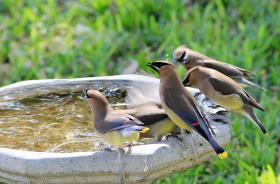Bird populations responding to climate change

With puzzling variability, vast numbers of birds from Canada’s boreal forests migrate hundreds or thousands of miles south from their usual winter range. These so-called irruptions were first noticed by birdwatchers decades ago, but the driving factors have never been fully explained. Now scientists have pinpointed the climate pattern that likely sets the stage for irruptions – a discovery that could make it possible to predict the events more than a year in advance.
The researchers found that persistent shifts in rainfall and temperature drive boom-and-bust cycles in forest seed production, which in turn drive the mass migrations of pine siskins, the most widespread and visible of the irruptive migrants. “It’s a chain reaction from climate to seeds to birds,” says atmospheric scientist Court Strong, an assistant professor at the University of Utah and lead author of the study.
Many seed-eating boreal species are subject to irruptions, including Bohemian and cedar waxwings, boreal chickadees, red and white-winged crossbills, purple finches, pine and evening grosbeaks, red-breasted nuthatches, and common and hoary redpolls. The authors focused on the pine siskin, a species featured prominently in earlier work on irruptive migrations.
Previous studies have found evidence that irruptions are triggered by food shortages caused by the large-scale collapse of seed production in northern pine, spruce and fir forests.
“We’ve known for a long time that weather was probably important, but prior analyses by ecologists have been unable to identify exactly what role weather was playing in this phenomenon,” says ecologist Walt Koenig, a senior scientist at the Cornell Lab of Ornithology and co-author of the new study incorporating climate science. “It’s a good example of the value of interdisciplinary work,” Koenig says.
To resolve the question, the scientists turned to a remarkable trove of data gathered by backyard birders as part of Project FeederWatch, a citizen science initiative run by the Cornell Lab of Ornithology. FeederWatcher volunteers systematically record bird sightings from November through early April and they gave the scientists more than two million observations of pine siskins since 1989. The crowd-sourced data makes it possible to track the movement of bird populations at a continent-wide scale.
Cedar Waxwings on a bird bath image via Shutterstock.
Read more at University of Utah.
2015©. Copyright Environmental News Network